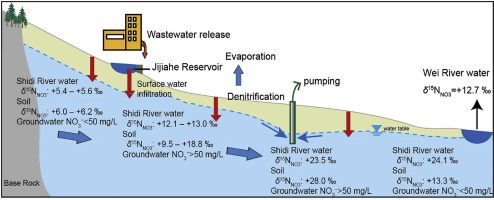当前位置:
X-MOL 学术
›
Appl. Geochem.
›
论文详情
Our official English website, www.x-mol.net, welcomes your feedback! (Note: you will need to create a separate account there.)
Use of multiple isotopic and chemical tracers to identify sources of nitrate in shallow groundwaters along the northern slope of the Qinling Mountains, China
Applied Geochemistry ( IF 3.4 ) Pub Date : 2020-02-01 , DOI: 10.1016/j.apgeochem.2019.104512 Hui Jia , Ken Howard , Hui Qian
Applied Geochemistry ( IF 3.4 ) Pub Date : 2020-02-01 , DOI: 10.1016/j.apgeochem.2019.104512 Hui Jia , Ken Howard , Hui Qian

|
Abstract Isotopes and major ion hydrochemistry are used to investigate potential sources of nitrate contamination in shallow aquifers along the northern slope of the Qinling Mountains, west-central China. Locally, nitrate concentrations exceed a remarkable 850 mg/L, over 40 times background levels observed in fresh mountain springs, and a knowledge and understanding of the nitrate pollution sources is essential for the development of aquifer management and protection strategies that will allow the problem to be effectively controlled. Presently, none of the suspected pollutant sources generates concentrations of nitrate that even approach levels observed in the groundwater, and this is clearly a challenge in terms of assigning responsibility for the contamination and developing appropriate management plans. However, stable isotopes of hydrogen and oxygen (δD and δ18O) in study area waters demonstrate that the centrally located Jijiahe Reservoir and Shidi River have been a major source of aquifer recharge in recent times and are an obvious source of the contamination. Moreover, δ15N–NO3– and δ18O–NO3– determinations suggest that, while nitrate concentrations in the river and reservoir are currently relatively low, a local, long-established fertilizer factory that has likely released high-nitrogen waste to these nearby receptors in the past, is the primary pollutant source. On a positive note, it would appear that the majority of the nitrate contamination, albeit serious in terms of drinking water quality, represents a legacy of past practice and should show gradual improvement due to modern-day environmental protection initiatives, improved equipment, better monitoring and significantly enhanced methods of wastewater treatment. However, the isotope data do indicate that the aquifer continues to be impacted by other anthropogenic activities, including agriculture and livestock raising, downstream of the industrial area and in the eastern part of the study area, meaning that monitoring and active remediation strategies need to be continued with vigilance.
更新日期:2020-02-01



























 京公网安备 11010802027423号
京公网安备 11010802027423号